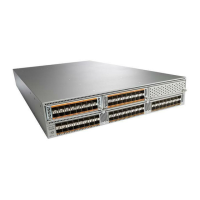Send documentation comments to n5kdocfeedback@cisco.com
1-14
Cisco Nexus 5000 Series NX-OS Interfaces Operations Guide, Release 5.0(3)N2(1)
Chapter 1 Virtual Port Channel Operations
vPC Failure Recovery
Installing a New Cisco Nexus 2000 Series Fabric Extender
With pre-provisioning, you can fully configure the new Fabric Extender before the Fabric Extender is
connected to a Cisco Nexus 5000 Series switch.
To install a new Cisco Nexus 2000 Series Fabric Extender, follow these steps:
Step 1 Pre-provision the slot with the Fabric Extender model.
Step 2 Configure the interfaces as though the Fabric Extender is connected.
Step 3 Connect the Fabric Extender and wait for it to come online.
Step 4 Verify that all configurations are applied correctly
Note The switch applies all configurations serially in a best-effort fashion when the Fabric Extender comes
online.
vPC Failure Recovery
This section describes different vPC failure scenarios and how to recover from them. This section
includes the following topics:
• vPC Member Port Failure, page 1-14
• vPC Peer Link Failure, page 1-15
• vPC Peer Keepalive Link Failure, page 1-16
• vPC Peer Switch Failure, page 1-17
• vPC Peer Link Failure Followed by a Peer Keepalive Link Failure, page 1-17
• vPC Keepalive Link Failure Followed by a Peer Link Failure, page 1-17
vPC Member Port Failure
Figure 1-1 shows the traffic flow when one vPC member port fails. Once the host MAC_A detects a link
failure on one of the port-channel members, it redistributes the affected flows to the remaining port
channel members. The return flow from MAC_C to MAC_A could take the path of the left- or the
right-side Cisco Nexus 5000 Series switch, depending on the port-channel hash algorithm of the top
switch. For those flows that traverse the right-side Cisco Nexus 5000 Series switch (the red line), the
Cisco Nexus 5000 Series switch passes the traffic to the left-side Cisco Nexus 5000 Series switch,
because it no longer has the local connection to host MAC_A. This is one of the scenarios where a vPC
peer link is used to carry data traffic.
We recommend that you provision enough bandwidth for peer links to accommodate the bandwidth
needed for link failure scenarios.

